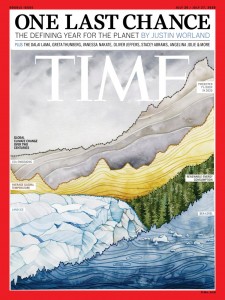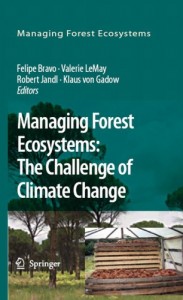From an Article by Justin Worland, TIME — America Must Change, July 9, 2020
It’s hard to imagine anything substantive so long as Trump is President. He and his GOP allies in Congress have an effective stranglehold on any policy that could push the U.S. to decarbonize, and thus far they have rejected big legislation to address climate change–portraying it as “socialist” and part of the Green New Deal that the progressive wing of the Democratic Party proposed last year to the derision of Republicans. Instead, the Trump Administration is reportedly preparing a $1 trillion infrastructure package focused on roads and bridges. “If we label it green, that would actually probably decrease its chances of being included,” said a Democratic congressional aide who works on energy and climate.
So the future of U.S. emissions will likely fall to the winner in the fall. Joe Biden, the former Vice President and presumptive Democratic presidential nominee, is well aware of the role the pandemic recovery will play in shaping emissions. Biden oversaw the last U.S. stimulus a decade ago in the midst of the Great Recession. That package totaled nearly $800 billion, with $90 billion for clean-energy measures, and helped launch many of America’s green advances, including funding Tesla’s transformation from a boutique car company to the world’s most valuable auto manufacturer; funding a program that doubled the fuel efficiency of Daimler Trucks’ Freightliner model; and supporting the weatherization of more than a million homes to reduce residential energy consumption. That package created 900,000 jobs and turned a profit for the government, even as it suffered high-profile failures like the collapse of the Solyndra solar-panel company.
Last year, Biden released a proposed Green New Deal, calling for $1.7 trillion in spending over 10 years on everything from electric vehicles to reducing pollution in low-income communities–all in service of the U.S.’s achieving net-zero emissions by the middle of the century. Since the coronavirus pandemic began, Biden has doubled down: he’s touted his Green New Deal and has appointed a committee that includes both longtime Washington climate advocates like former Secretary of State John Kerry and emerging leaders of the Democratic progressive wing like current New York Congresswoman Alexandria Ocasio-Cortez to craft new climate policy.Top congressional Democrats, signaling support for a big climate package, unveiled a 500-page legislative road map on June 30 that includes tax incentives and infrastructure spending to eliminate the country’s carbon footprint by 2050. It won’t become law this year, but it sends a signal that the issue will be on the legislative agenda if Biden wins in the fall.
“We’ve got to strike now. We can’t let this go,” Biden said at a League of Conservation Voters virtual event on June 16. “Not because of me but because of the opportunity.” Importantly, Biden has promised to re-engage with the rest of the world on the issue, including by helping fund climate measures in developing countries. China wouldn’t be eligible to receive such funding, but the nation is keeping a close eye on how U.S. climate policy is unfolding. China has delayed several key decisions and signaled its intention to hold off making new climate commitments until after the U.S. presidential election. Even after three years of Trump’s tearing down the U.S.’s global reputation on climate, it turns out the U.S. is still leading the world. In what direction remains to be seen.
To many who study climate, the pandemic looks eerily familiar. At first, the new virus seemed distant and inconsequential to most people, so long as you weren’t in the eye of the storm. The rest of the world watched in amazement as China shut down Wuhan. Horror stories of patients dying in hallways in Milan shocked the U.S., but not enough to make the nation prepare. In late February, at the last Democratic primary debate before voting in the critical state of South Carolina, moderators didn’t ask about the issue until one hour and 15 minutes into the discussion, and spent less than five minutes on it.
Researchers estimate that by the time the U.S. collectively woke up to the stakes of the pandemic on March 11 — the day Tom Hanks said he tested positive, the NBA canceled its season and Trump banned travelers from Europe — thousands of people had already been infected in the country. In the few months since, more than half a million people have died worldwide, including some 100,000 in the U.S., and there’s no sign we’ll be rid of the virus anytime soon.
The story of climate change has unfolded over decades, but its trajectory is much the same. For years, we’ve watched as the evidence has grown. We’ve gaped as superstorms have battered the globe from Bangkok to Houston and unprecedented heat waves have popped up, killing a few thousand here and there.
As I write this, it’s 100°F in Siberia, and wildfires are raging in an area infamous for its yearlong ice. “These are the warning signs” of cataclysmic climate change, says Gail Whiteman, a professor at Lancaster University who runs an Arctic research program.
If Wuhan and Milan offered a preview of what the U.S. is now experiencing with COVID-19, where should the country look for a glimpse of a climate-changed world? Last year, I traveled to Fiji and found that for many of those living on the small Pacific Islands, on the front lines of brutal storms and sea-level rise, climate change is already the defining issue. If a storm destroys a school, students can’t learn. If the sugarcane crops are flooded, farmers lose their jobs. If sea levels rise too much, entire communities disappear. Climate concerns are at the center of their economies and the center of their development plans.
“This can’t be the purview of even 25,000 or 40,000 or even 100,000 people,” says Christiana Figueres, who led the U.N. climate-change body during the Paris climate talks. “This has got to permeate through every single corner, every single channel, every single flow of economic development and modernization. It’s got to become the new norm.”
That will come one way or another. Every country will be combatting climate change for the foreseeable future; the change in climate we’re experiencing today is in large part the result of emissions that happened more than a decade ago. However, we do have a choice of how bad it will get. If we invest in preserving nature and transitioning our energy system today, we will stave off the worst, giving us the ability to manage the hurricanes and floods as they come. If we wait, we’ll be stuck flat-footed when the worst arrives, watching in dismay as the temperature curve ticks up and up.
The choice is ours. We just don’t have much time to decide.
### — This series, Parts 1 thru 4, is from the July 20, 2020 issue of TIME. Buy a copy, support meaningful journalism and pass it on to a friend or a colleague or another voter.



{ 1 comment… read it below or add one }
The Seekers – The Times they are a-changin’ – Rare Stereo version – YouTube
https://www.youtube.com/watch?v=NNh5870rBkc